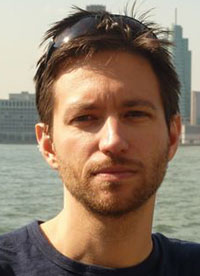2014 André Aisenstadt Prize in Mathematics Recipient
Sabin Cautis (University of British Columbia)
[ français ]
Details on the lecture held October 17, 2014
 The International Scientific Advisory Committee of the Centre de recherches mathématiques (CRM) is happy to announce that Sabin Cautis from the University of British Columbia is the 2014 André Aisenstadt Prize recipient. The International Scientific Advisory Committee of the Centre de recherches mathématiques (CRM) is happy to announce that Sabin Cautis from the University of British Columbia is the 2014 André Aisenstadt Prize recipient.
As an undergraduate student at the University of Waterloo, Dr. Cautis was a Putnam Fellow and a member of the winning team in the 1999 Putnam competition. After receiving a Bachelor of Mathematics degree in 2001, Sabin Cautis continued his education at Harvard University, where he obtained his Ph.D. in 2006 under the supervision of Joe Harris. Before joining the mathematics department at UBC, Dr. Cautis was assistant professor at the University of Southern California and held postdoctoral positions at Columbia University, MSRI, and Rice University. In 2011-2013 he was a recipient of the highly coveted Alfred P. Sloan Fellowship.
Sabin Cautis works at the crossroads of algebraic geometry, representation theory, and low-dimensional topology. In his earlier work (joint with the 2011 André Aisenstadt Prize recipient, Joel Kamnitzer), he developed a new approach to Khovanov's knot invariants, which uses algebraic geometry and is inspired by mirror symmetry. Dr. Cautis is a world leader in the area of categorification. His results are expected to have a lasting impact on the field and lead to important developments in low-dimensional topology, the geometric Langlands program, and the mathematical aspects of quantum physics. In particular, his recent work with Anthony Licata on categorification of Heisenberg algebras and vertex operators is a major step in the direction outlined by Igor Frenkel towards categorification of conformal field theory.
|